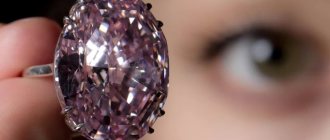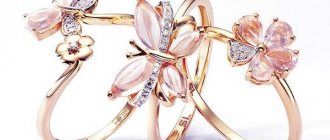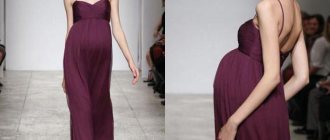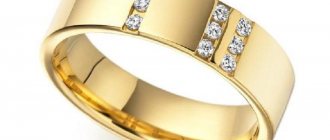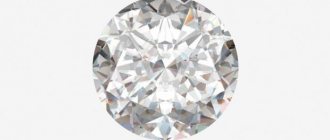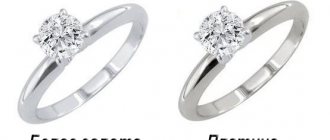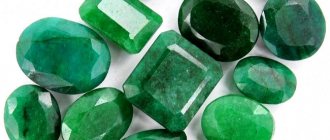Purchasing a diamond? not worth on par with any other purchase. After all, this stone can shine in decoration, become a profitable investment, or combine these two positions. To make a profitable purchase, you should rely on the criteria for jewelry evaluation of stones. Not only the external attractiveness of the gem, but also the final cost of the processed diamond depends on the parameters that determine the purity and color of the diamond.
Diamond classification
To evaluate a diamond, the 4C classification is most often used. The following characteristics are taken into account:
- color shade;
- cutting;
- weight (measured in carats);
- diamond purity.
Cut
The price of a precious mineral largely depends on the quality of the cut. It is needed to reveal the internal play of color and enhance shine. It also helps to emphasize specific lighting effects, obscure minor defects in diamonds, but preserve the natural size of the gem as much as possible.
Diamond Clarity
All natural minerals contain non-crystallized inclusions of various elements, as well as small foreign crystals.
Diamonds are classified based on their purity.
As a rule, these inclusions cannot be seen with the naked eye. They are revealed under multiple magnification.
Diamond color
Diamonds are also graded by color. True, most crystals are colorless. Only some have additional shades. Their color varies from light blue to yellow and even brown.
Weight
When assessing the value of diamonds, their weight is taken into account. Its measurement is carat. 1 ct equals 0.2 g. Taking this parameter into account, the following groups of minerals are distinguished:
- small – up to 0.29 ct;
- medium – from 0.3 to 0.99 ct;
- large – from 1 ct.
The larger the size of the gem, the higher its value.
Assessment systems
For a long time, there was no classification to evaluate the clarity of diamonds. But since the 50s of the last century, employees of the Gemological Institute of America (GIA) took up this issue closely and created the 4C grading system, which is still the basic one.
According to the new system, the characteristics that determine the value of the gem were assessed:
- diamond clarity;
- color;
- weight;
- cut.
Specialized institutions and certified specialists have the right to evaluate.
The most authoritative are:
- Supreme Diamond Council of Belgium;
- World Jewelry Confederation (Switzerland).
In our country, the Gemological Center of Moscow State University is considered the main appraiser.
Watch the video with interesting facts and tips on choosing a stone:
Diamond clarity rating
The purity of a diamond can be determined using an international as well as a Russian scale. Each rating system has a number of features.
Russian scale
The Russian purity scale is based on the fact that the distribution takes into account the number of facets and carat content of the mineral:
- small specimens with 17 edges – 6 degrees;
- not exceeding 0.299 ct with 57 facets – 9 degrees of purity;
- weighing from 0.3 ct with 57 facets – 12 categories.
The higher the category, the lower the quality of the gem. For all minerals, the first categories are considered the best. Such stones are free of foreign inclusions and all kinds of flaws.
GIA Score
The diamond scale is based on size, as well as parameters such as clarity and number of inclusions. Cut and carat are not taken into account.
Diamond clarity table according to the international classification according to the GIA system
| Class | Designation | Characteristic |
| F | Flawless | Ideally pure mineral |
| IF | Internally Flawless | Close to ideal |
| VVS 1, VVS | Very Very Small Inclusions | There are very minor inclusions |
| VS 1, VS 2 | Very Small Inclusions | The presence of very small inclusions is noted |
| SI 1, SI | Small Inclusions | Small inclusions |
| I 1, I 2, I | Imperfect | Instances are far from ideal |
Correlation of purity scale indicators
The clarity of the diamond must be indicated on the tag. True, the rating scale is different. A comparative table of classification systems will help you make the decoding correctly.
| GIA | Russia | Description | ||
| Up to 0.299 ct | From 0.3 ct | |||
| 17 faces | 57 faces | 57 faces | ||
| F | 1 | 1 | 1 | No defects were found |
| IF | 2 | 2 | 2 | The presence of one, maximum two light points. There may be a small stripe |
| VVS 1, VVS 2 | — | 3 | 3 | No more than three light dots or a maximum of two faint lines of a dark shade |
| — | — | — | 4, 4a | 1-2 dark spots. They are faintly noticeable and located deep. Possible presence of up to four light spots or a surface crack |
| VS 1 | 3 | 4 | 5 | A light haze or a small crack in the depths, no more than six light fragments in the form of dots, stripes, or a maximum of three dotted inclusions of a dark shade |
| VS 2 | — | 5 | 6, 6a | Maximum of one graphite inclusion. The structure of the gem contains up to eight light fragments and cracks. 1-5 dot dark fragments |
| SI 1, SI 2 | — | — | 7, 7a | Presence of graphite haze, maximum 2 graphite inclusions, no more than eight minor flaws in total |
| SI 3 | 4 | 6 | 8 | Numerous but minor defects. Some of them can be seen under a magnifying glass, but with difficulty |
| I 1 | — | — | 9 | Cracks are visible even without the use of magnifying devices or are accompanied by inclusions |
| I 2 | — | 7 | 10 | Lots of defects. Transparency of at least 60% |
| I 3 | 5 | 8 | 11 | There are many flaws, and transparency varies between 30-60% |
| — | 6 | 9 | 12 | A large number of defects. Transparency no more than 30% |
On large diamonds of 3-6 degrees of clarity, it is impossible to see flaws without a magnifying glass. Visually, defects are detected only on copies of category 7 and higher.
On minerals weighing less than 0.299 ct they are already detected at marking 6 on the label.
The most famous types of diamonds
The simplest distinction is between man-made and natural. But stones are also differentiated by area of application. They are divided into:
- jewelry;
- technical.
By place of extraction:
- open;
- career;
- mine;
- mine;
- mine;
- underwater.
This is interesting! Most of the mined diamonds are “technical” stones. Only 20% of extracted minerals are suitable for jewelry processing.
The transparent diamonds we are used to are giving way to colored diamonds:
- yellow;
- brown;
- blue;
- pink;
- purple;
- red;
- green;
- black.
By cut type:
- diamond;
- cabochon;
- steps;
- wedges
By form:
- round;
- a drop;
- oval;
- rectangle;
- pear;
- princess;
- awning;
- usher;
- heart;
- emerald.
Diamond 1/1
Very rare - diamonds are absolutely colorless, without flaws . How much is 1/1 worth? At retail, the price of a one-carat specimen soars to one and a half to two million rubles.
Diamond 2/2
These stones already have a slight yellow or brownish tint and barely noticeable defects. The price is 2/2 lower than that of ideal stones, but not by much.
Diamond 3/3, 4/4 and others
Diamonds 3/3, 4/4 and others, which have a clear and rich color, flaws of various origins and sizes, can differ significantly from each other and, of course, from ideal stones , costing the same weight.
The price varies depending on the size and visibility of the flaws.
Diamond color
The assessment of diamonds by color differs in European countries and Russia. There are two options for classifying crystals based on their shade.
Russian scale
The color of the diamond in this case is determined on several scales. The carat value of the mineral and the number of facets are taken into account.
Gems with 17 facets are divided into the following groups:
- a white, bluish tint is faintly noticeable;
- faint yellow tint;
- a yellow or white gem with a pronounced color tint;
- brown.
Minerals with 57 facets, not exceeding a mass of 0.299 ct, are divided into 7 groups:
- 1 – the mineral is white, the bluish tint is faintly noticeable;
- 2-3 – a faint light yellow reflection is noted;
- 4 – white specimen with a noticeable color tone;
- 5 – yellow;
- 6-7 – brown minerals.
57-carat minerals weighing more than 0.3 ct are divided into 9 categories:
- 1 – white-blue;
- 2-3 – shade barely perceptible to the eye;
- 4-5 – slightly noticeable yellowness;
- 6-7 – presence of clearly visible color;
- 8 – yellow;
- 9 – brown.
Minerals are not compared with a standard. Their appearance is assessed by verbal description. The concepts are very vague.
GIA Score
When using this system, the color shade is assessed on two scales (for fancy and colorless minerals). Gradation taking into account the number of facets and carats is not provided in this technique.
The shade is determined by comparing the sample with a reference mineral. White gems are divided into categories according to the letters D to Z. Crystals marked D are considered completely colorless. Starting from grade K, yellowness appears, which becomes most noticeable in category Z. Such minerals are already called yellow.
Colored rather than white minerals are classified into separate groups based on color. They were united under the common name Fancy for crystals. This scale is significantly different from the previous one. The darker the gem, the more valuable it is.
Correlation of color scale indicators
Comparative characteristics of the correspondence of the two scales will help you more easily understand the information on the tag.
| GIA | Russia | |
| Up to 0.299 ct | From 0.3 ct | |
| D | 1 | 1 |
| E | 1 | 2 |
| F | 2 | 3 |
| G | 3 | 4 |
| H | 3 | 5 |
| I | 4 | 6 |
| J | 4 | 7 |
| KZ | 5 | 8 (1-5) |
| 6 | 6 (1), 9 (1-4) | |
| 7 | ||
What to prefer - color or clarity
Color and purity are two important criteria that indicate the quality of precious minerals. On the tag they are placed side by side in the form of regular numbers. The first point is given to color, and the second to purity, and it is problematic to understand exactly which of these indicators should be better.
When choosing, the following circumstances are taken into account:
- Priority is given to color if a specific setting is provided for the gemstone. If the frame is white, then visible shades are extremely undesirable. In this combination, the yellowishness will be pronounced.
- Clarity is important if the stone is to be set in yellow gold. This metal will absorb the yellowness. The mineral will visually appear white. True, if its quality is low, the dirt on it will become pronounced. The gem should look absolutely clean.
What is a quality certificate
If jewelry made of precious metals is stamped to confirm their quality, then a certificate is issued for diamonds. This is a guarantee of the authenticity of the purchased mineral. It contains information about the correspondence of the cost of the gem to its quality.
The certificate contains the following information about the stone:
- absence or presence of defects;
- their location inside the mineral;
- the scope of identified deficiencies;
- quantity.
The document does not indicate the price of the mineral.
The certificate is intended solely to describe the quality of the gem. Four main parameters are taken into account:
- weight;
- color;
- quality and type of cut;
- clarity.
The report must indicate who issued this document. Many companies have the right to certify gemstones. However, only two laboratories guarantee assessments to high standards. These organizations are located in the United States:
- Jewelers Association;
- Gemological Institute.
Examinations in these laboratories have been carried out since 1931. They have a good reputation and have earned special trust. The mineral is placed there in a separate case. Data about the owner, place of extraction of the crystal and other important information are not indicated.
During the evaluation, scientists study the structure of the diamond. After which a report is issued. In this document, they describe all the characteristics of the gem and establish its true value. After such a thorough check, there is simply no reason to doubt the authenticity of the stone.
The advantage of these two organizations is the lack of commercial interest. Accordingly, the appraiser cannot be persuaded to give false information about the value and quality of the sample being examined. The examination is carried out fairly and impartially.
Purchase authentication technology
In pawnshops, precious stones are valued using the 4C system. Initially, the specialist weighs the gem and thus determines its size in carats. After this, using the correspondence table, the sample under study is correlated with the color scale.
Fancy and completely transparent crystals are considered the most expensive. Choosing a color category is far from an easy task. Initially, the appraiser examines the mineral visually and then subjects it to multiple magnifications.
To give a correct assessment, only tools that do not give glare into the depth of the product are used. Lighting fixtures should emit white, and instruments should only be gray or black.
At the next stage, the specialist determines the purity category. After this, he needs to assess the quality of the cut, how accurately and skillfully it was made. If a mineral is poorly processed, you can even notice it with the naked eye. All other flaws can only be seen with magnification. This also makes assessment much more difficult.
Certification and color ranges.
Always ask if the diamond you are looking at is certified, preferably by the GIA or another equally reputable organization. If there is no certificate, there is no way to know the exact color grade of the stone, no matter what the seller tells you.
Be careful if someone tries to sell you a diamond by defining its color as a range of letters rather than an exact grade.
The GIA grades color using specific letters, and if a seller tells you that a diamond is graded DF or something similar, it most likely means that the seller does not know what the exact grade of the diamond is.


